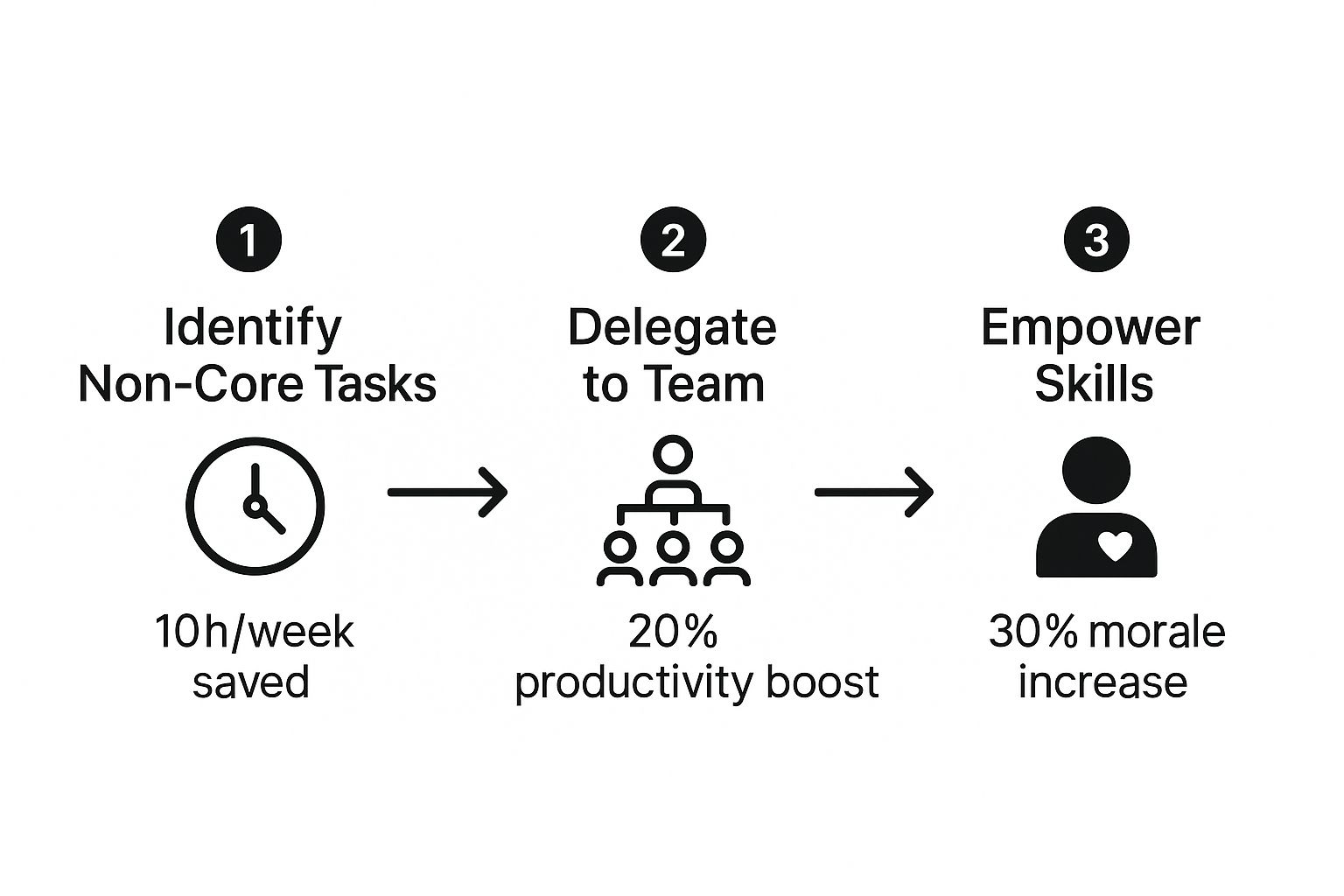How to Delegate Tasks Effectively and Boost Team Growth
Learning to delegate tasks effectively is so much more than just clearing your to-do list—it's a critical leadership strategy for scaling your business. At its core, it's about empowering your team with ownership, which frees you up to focus on the high-impact activities that actually move the needle.
Why Smart Delegation Is Your Ultimate Growth Lever
I've seen so many founders and managers fall into the "I'll just do it myself" trap. It feels productive in the moment, but in reality, it creates a massive bottleneck that stifles growth and leads directly to burnout. True delegation isn't about offloading work you don't want to do. It's about strategically distributing responsibility to build your team's skills and create a more resilient, capable organization.
When you make the shift from being the primary "doer" to a leader who empowers others, the benefits are immediate and compounding:
- You build capacity. Your team can handle more, allowing the business to take on new projects and serve more clients without you being the single point of failure.
- You develop your people. Team members get to stretch their skills by tackling new challenges, making them more confident and valuable in the long run.
- You boost morale. Trusting your team with important work shows you value their abilities. That trust is a huge driver of job satisfaction and engagement.
This transition fundamentally changes your role, letting you step back from the day-to-day grind to focus on strategy and vision. This infographic really drives home the tangible benefits of getting this right.

The data is clear: identifying the right tasks and assigning them to the right people directly boosts productivity and morale, creating a powerful growth cycle. A Gallup study even found that CEOs with strong delegation skills saw a three-year growth rate 112 percentage points higher than those who struggled with it. That’s not a small difference.
Effective delegation is the bridge between a manager who is merely busy and a leader who is creating impact. It's about multiplying your effectiveness through others, not just managing your own time.
By mastering this skill, you directly improve your organizational effectiveness and lay the foundation for sustainable growth. For delegation to truly work as a growth lever, it has to be paired with a strong workforce. You can explore more on strategies for building high-performance teams to see how these concepts fit together.
Quick Delegation Readiness Checklist
Before you hand off a task, it pays to do a quick mental check. This isn't about overthinking it, but about setting everyone up for success from the start.
Use this checklist to quickly assess if a task is a good candidate for delegation and if your team member is truly ready to take it on.
| Readiness Check | Criteria for 'Yes' | Action if 'No' |
|---|---|---|
| Is the task repeatable? | The process is documented or can be easily explained and will be done again. | Document the process first, or handle it yourself if it's a one-off. |
| Does the person have the skills? | They have the necessary technical or soft skills, or the capacity to learn them. | Provide training, resources, or pair them with a mentor before delegating. |
| Is the outcome clear? | You can define what "done" looks like with specific, measurable results. | Clarify the goal and key metrics before you even think about assigning it. |
| Do they have the authority? | They have the necessary access to tools, people, and information to succeed. | Grant permissions and make introductions to key stakeholders upfront. |
Running through these questions takes just a few minutes but can prevent hours of frustration and rework down the line. It turns delegation from a risky guess into a calculated, strategic move.
Choosing the Right Tasks and People for Delegation

Learning how to delegate effectively really begins with an honest look at your own to-do list. A lot of managers trip up here, feeling like every single task is something only they can handle. The trick is to get good at separating the work that genuinely requires your unique expertise from the things that could be a fantastic growth opportunity for someone else on your team.
A simple way to start is by sorting your daily and weekly tasks into two piles. In one pile, put the high-level, strategic work that steers the ship—things like finalizing a major client deal or setting the product vision for the next six months. Everything else goes into the second pile.
The best tasks to delegate are often hiding in plain sight. They're usually the things you're good at but that don't stretch you anymore, and they're holding you back from tackling the bigger picture.
That second list is your goldmine for delegation. Now, it's time to find the right owner for each task.
Matching Tasks to Team Members
Deciding who gets what is so much more than just offloading work to the person with the most bandwidth. Great delegation is about making a strategic match between what the task demands and where a team member wants to grow. In fact, this is a crucial part of your ongoing talent acquisition best practices because it's how you develop and keep the great people you’ve already hired.
Before you hand anything over, take a moment to consider a few key things:
- Who has the right foundational skills? You're looking for someone with the basic know-how to hit the ground running, even if they'll need a bit of your guidance along the way.
- Who has shown interest in this type of work? When you align a task with someone's career aspirations, their motivation goes through the roof.
- Who would benefit most from learning this skill? Think about who you're grooming for future roles. This task could be the exact experience they need.
When you approach it this way, delegation stops being a simple hand-off and becomes a direct investment in your team's development. As a powerful side effect, smart delegation means more work gets done in parallel, which busts up the bottlenecks that micromanagement creates. According to one study on operational efficiency, this approach significantly boosts team output. You're not just getting work off your plate; you're building a more skilled, autonomous, and motivated team.
How to Give Instructions That Actually Get the Job Done

Let's be honest, the single biggest point of failure in delegation isn't a lack of skill or motivation. It's almost always vague instructions. When a task goes completely sideways, you can usually trace it back to a communication gap right at the start.
Simply telling someone what to do is a recipe for disappointment. You have to arm them with the why behind the task. When you connect their work to a bigger company goal, you give them the context they need to make smart, independent decisions. They won't need to circle back for every little thing.
Think about the difference here:
- Vague: "Can you get me a report on our Q3 social media performance?"
- Clear: "I need a report on our Q3 social media performance. The goal is to show the leadership team which channels drove the most SaaS trial sign-ups. That data will help us decide where to double our ad spend for Q4."
The second one is a game-changer. It empowers your team member to hunt down the metrics that truly matter, not just pull a bunch of vanity numbers and hope for the best.
Building the Perfect Delegation Brief
A solid brief doesn't have to be a 10-page document. It just needs to cover the essentials to kill any ambiguity and set crystal-clear expectations. Think of it as a pre-flight checklist before the task takes off.
Here’s what I always include:
- The Desired Outcome: Define exactly what "done" looks like. Is it a polished report, a live campaign, a refined prospect list? Be specific.
- Success Metrics: How will you both know the task was a home run? Spell out the KPIs. For instance, "increase demo requests by 15%" or "cut down customer support tickets by 20%."
- Key Resources: Give them the keys to the car. This means access to all the necessary tools, documents, and contact people. Nothing grinds a project to a halt faster than hitting a permissions wall.
- Deadlines and Check-ins: Set a realistic final due date, but also schedule a couple of quick check-ins along the way. This lets you monitor progress without breathing down their neck.
A well-structured brief transforms delegation from a risky hand-off into a predictable process. It respects your team member's time by giving them everything they need to succeed from day one.
For more complex or repeatable tasks, writing these instructions down is non-negotiable. If you need a good starting point, our article on how to create training manuals has a fantastic framework you can easily adapt.
By investing a little extra time upfront to provide clear, thorough instructions, you radically improve your chances of getting the exact result you were hoping for.
Trusting Your Team Without Micromanaging

Okay, you've handed off the task with perfectly clear instructions. Now for the hard part: letting go. It’s incredibly tempting to peek over their shoulder or jump in to "correct" something that isn't exactly how you would do it. But giving in is the fastest way to crush morale and kill any sense of ownership.
Micromanagement does more than just annoy people; it flat-out tells them you don't trust their skills. Effective delegation means shifting your focus from policing the process to evaluating the outcome.
Striking the Right Balance with Check-Ins
There’s a fine line between offering support and stifling autonomy. The trick is building a system for accountability that feels supportive, not controlling. Ditch the "Are you done yet?" approach for something more collaborative.
Set a clear rhythm for check-ins right from the start. This could be a quick 15-minute sync a couple of times a week or a simple end-of-day note in your project management tool. The key is to frame these touchpoints around progress and roadblocks, not just scrutiny.
Here’s how to make it work:
- Ask empowering questions. Instead of "What have you done?" try, "How's it going?" or "Is there anything you need from me to clear the path?"
- Focus on the result. If the final product meets the goals you agreed on, don't sweat the minor differences in method. Their way might even be better.
- Make it safe to fail. Encourage your team to flag issues early without fearing blame. This is how you build a proactive culture where problems get solved fast.
Trust is the currency of great delegation. When you give your team the space to truly own their work, you get back way more in engagement, new ideas, and genuine job satisfaction.
This isn't just a feeling; it's backed by research. The principles behind the Hackman and Oldham job characteristics model show a direct link between workplace autonomy and employee well-being. When people have freedom, they're happier and more satisfied. This is even more critical when you're managing remote teams effectively, where trust is the glue holding everything together.
The Post-Game Analysis: Using Feedback to Sharpen Your Delegation Skills
So, the task is done and delivered. Job over, right? Not so fast. The most important part of the entire delegation process often happens after the project is complete: the debrief.
This is your chance to close the loop. Think of it less like a formal meeting and more like a quick, collaborative huddle. This simple step is what separates okay delegation from great delegation, turning a single task into a masterclass for the next one. When you build this into your rhythm, you’re not just getting work done; you’re building a smarter, more capable team.
How to Run a Debrief That Actually Works
The whole point is to get a real, unfiltered look at how things went—from your team member's perspective. You need to make it a safe space for them to be honest about the good, the bad, and the clunky.
Forget a formal review. Just grab a few minutes and start a casual conversation. I find a simple three-part framework keeps these chats on track and productive.
- Kick Off with a Win: Always start with genuine, specific praise. Don't just say "good job." Try something like, "That slide deck was fantastic. The way you visualized the Q3 data made it incredibly easy for the leadership team to grasp." This shows you're paying attention and value their specific contributions.
- Dig Into the Challenges: Now, get curious about their experience. Ask open-ended questions like, “Talk me through the process. Were there any roadblocks you had to navigate?” or “At what point did you feel like you were hitting a wall?” This uncovers hidden issues you might not have seen.
- Look Ahead Together: Frame the conversation around future improvements. A great way to put it is, “If we had to tackle this same project again next month, what’s one thing you’d suggest we do differently to make it even smoother?” This makes it a shared problem to solve, not a critique of their performance.
The secret to becoming a master delegator isn’t just in the assigning; it’s in the learning. A consistent feedback loop is the engine that drives improvement, turning one-off tasks into repeatable systems and growing your team's confidence with every project.
These quick check-ins are invaluable. You’ll learn exactly where your team excels, spot gaps where a bit more training could help, and get direct feedback on how to make your own instructions clearer next time. It’s a small investment of time that pays massive dividends.
Common Questions About Delegating Tasks
Even the best-laid delegation plans can hit a few snags. Let's walk through some of the most common questions and concerns that pop up when leaders start handing off work. These are the things that can keep you up at night, but they all have practical solutions.
What If They Do It Differently Than How I Would?
This is a classic—and a big one. It's easy to get caught up in the "how," but great delegation is all about focusing on the "what." The real question is: did the final result meet the standards we agreed on?
If the outcome is solid and delivered on time, a different approach isn't a problem; it's often a sign of creativity and independent problem-solving. Give your team the space to find their own way. You should only step in if their method is genuinely inefficient, introduces unnecessary risk, or is about to derail another part of the project. Otherwise, take it as a chance to learn a new way of thinking.
How Can I Delegate to Someone Who's Already Swamped?
You can't just drop another task on an already full plate and hope for the best. That's a recipe for burnout. The first step is always to have an honest conversation about their current workload and what they can realistically handle.
Frame the new task as a growth opportunity—a chance to develop a new skill or take on more responsibility—not just another to-do item. Then, work with them. Can another project be pushed back? Can a lower-priority task be handed to someone else? This collaborative approach shows you value their time and trust them to manage their own priorities, which is a crucial skill for them to build anyway.
Delegation is about empowerment and growth; simply offloading work is dumping. True delegation includes providing the 'why,' defining success, ensuring the person has the right resources and authority, and viewing it as a chance for them to learn and develop new skills.
Dumping is when you assign something with zero context or support. It creates stress and resentment. By focusing on genuine delegation, you're not just getting work done; you're actively building a stronger, more capable team.
At MakeAutomation, we build the systems and processes that help teams work smarter, not harder. If you're ready to stop drowning in manual tasks and create an operation that can truly scale, we know how to get you there. Explore our AI and automation solutions today.







